Auschwitz is one of the most notorious concentration camps even still today. 11 million people in all were murdered during the Holocaust. 6 million victims were Jews. The other 5 million were Gypsies, POWs, criminals, political prisoners, and basically anyone against the Nazi party.
I was fortunate to have the opportunity to visit such a place where such atrocities took place. This blog will serve as a reflection on my experiences in both Auschwitz and Birkenau.
I have always been interested in learning about the Holocaust. In fact, I started to do a study of my own because I knew there was much more than the history books told. I have studied this topic for seven years and I thought I knew it all. This experience proved me wrong.

Photo I took at Auschwitz I gate. “Work sets you free.”
Walking through Auschwitz I, I did not feel anything close to what I felt at Birkenau. You see, Auschwitz I is more of a museum. Yes it was used as a labor camp, but with everything reconstructed over the years it did not feel authentic to me. Things such as taking out the beds that the victims’ had slept on and turning the barracks into a museum set up is just one example.
Another example, one of the barracks had
been turned into a bathroom and I felt that this was very disrespectful. My thought was that people had died in there. I was ashamed that I had used that restroom.
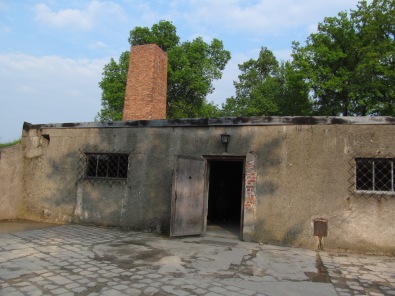
Photo I took outside of the gas chamber at Auschwitz I.
The last thing, the gas chamber. I had read so many stories of victims saying how people was climb on top of each other and leave nail markings on the wall.
Those markings were gone. The tourist that had came through had left new markings. I understand the symbolism of this, but the entire thing felt tourist-y.
It was hard to imagine the life the victims lived here.
However, everything I saw in Auschwitz I prepared me for Birkenau. All of the information given to me gave me a better understanding of the camps and the Holocaust.
Birkenau had a completely different atmosphere. I had heard Birkenau called the largest memorial/cemetery multiple times. I understood the symbolism behind it, but I did not fully understand what was meant until I walked through the camp.
Walking through the notorious “Gate of Death” intimidated me. Even when I walked out I was afraid. This 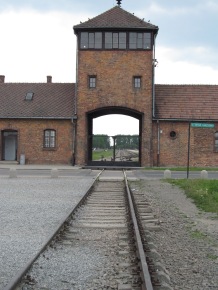 was the largest Nazi death camp killing around 1.2 million people. This includes not only Jews, but Gypsies, POW, political prisoners, etc. Treblinka following behind with around 850,000 deaths.
was the largest Nazi death camp killing around 1.2 million people. This includes not only Jews, but Gypsies, POW, political prisoners, etc. Treblinka following behind with around 850,000 deaths.
As I walked into the remains of the camp I felt something. It was almost as though each victim had left a part of themselves behind. That was an overwhelming feeling but it was also a very powerful one.
I saw the tracks. Yes, the tracks that brought millions to their deaths. From the outside looking in I thought they were infinite. Little did I know that they had led to the most preferred method of killing, the gas chamber. There were four gas chambers total in Birkenau but now only rubble stands in their place.
Our first stop was the men’s side of the camp. All of the barracks were wooden. The wood was taken from barns that had previously been on that
land. When I walked into the barrack I was surprised that there was light coming in from the top through a window like structure. I looked around and thought about how much these “living quarters” resembled a barn.
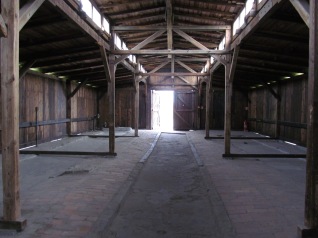
Photo I took inside of one of the men’s barrack.
The left side of the camp was the women’s camp. There were some barracks that were made of brick, but once the Nazi ran out of brick they used wood. The barracks on this side started out bigger and then became smaller and smaller. It seemed like the smaller the barracks were the more victims were forced in there.

Photo I took in the women’s section of the camp
I never realized how massive in size the camp was. I also never realized that there was a section of the camp dedicated to gypsies. Here conditions were better than normal. From what I gathered, this was because the Nazis did not want them to suspect that they would be gassed. There were 23,000 gypsies and I was told that 21,000 were exterminated.
This type of treatment was not uncommon in Birkenau. The Nazi are known for deception, I mean just look at Hitler. Hitler and the Nazi were not stupid by any means. How do you get people to believe that the Aryan race is the most superior? How do you get people to hate a people group? These tactics were used still in the camp. The victims even knew how deceptive the Nazis could be.
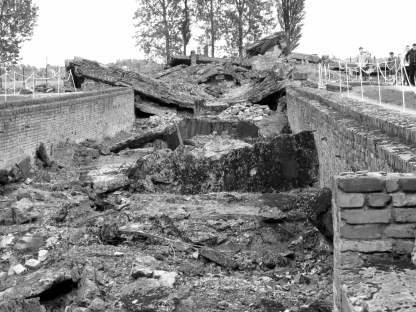
Photo I took of the remains of the gas chamber/crematorium.
The sonderkammando were prisoners who were one of the most favored. There job was to work in the crematoriums that burned the bodies that had just been gassed. They lived above the crematorium/gas chamber. The Nazis purposely kept them separate from other prisoners because of the information they held. These prisoners burned their family, neighbors, and other loved ones.
As I walked past the remains of these gas chambers/crematoriums I was astonished. How could these people keep going on like this? I tried to put myself in their position but I could not. I have no idea what I would have done. They were strong individuals. They were stripped of humanity and then forced to do the same to others. I cannot fathom this to this day.
There was a memorial at the end of all of the gas chambers/crematoriums. I do not know what this space was used for before, but I was glad there was a memorial there. There were plaques in multiple languages in honor of the victims. Those plaques stood in front of a stone monument in their honor as well. There were steps at the end of those tracks that I
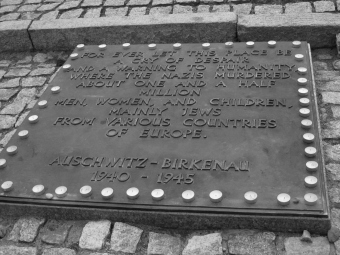
Photo I took of plaque in English.
thought never ended. I was overwhelmed with emotion that I had to sit down.
I sat down in honor of those victims and gave them the moment of silence that they deserve. I could not formulate thoughts for many minutes. This was all so much to take in and I wanted to process it correctly. I wanted to know what could I have possibly learned from this. I thought about how I can use this experience in my classroom one day. I longed for immediate answers but struggled to find them.
When I headed back towards the “Gate of Death” I had a different view of this camp. In honor of that different view I decided to walk the tracks all the way back. This symbolized a hope for the future, that something as horrendous as this may never happen again. I walked those tracks for those who never had the chance, for those children who lost their childhood. I walked those tracks for me. So that I can always remember the promise I made to myself that day.
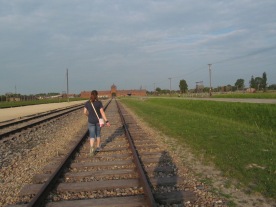
Me walking towards the “Gate of Death.”
I promised myself that I would share my story of everything I saw here, and I promised myself that I would incorporate this theme of hope into my future classroom. Now as I sit here typing this on the floor of my bathroom, I know this is just the beginning of me sharing my story. I will speak for those who never had the chance and keep this part of history alive.
I now challenge you, my readers, to never forget what barbaric atrocities that happened during the Holocaust. Not only the Holocaust, but any time in history where many lives were lost to those who considered themselves “superior.” It is still happening today, even if 11 million lives were not lost. It is happening in schools with bullying, in other countries based on beliefs, and all over the world. That is why this all matters.
If you have interest in looking at my photos from my trip to Poland here is the link.
